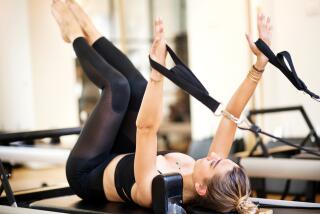Pilates as a lifestyle choice
- Share via
It’s official: Pilates has gone from being just an exercise to a full-on lifestyle. At least that’s the opinion of the new Pilates Style magazine, a polished quarterly publication covering the ever-expanding world of Pilates, from how to find a studio to what to wear to class, destination spas, makeup tips and step-by-step exercises.
As an exercise program, Pilates concentrates on developing core muscles through toning and stretching, which can be done with and without equipment. It was developed about a century ago by German immigrant Joseph Pilates and was adopted by ballet dancers before hitting the mainstream in recent years. Its popularity has fueled a marked increase in Pilates studios, workout videos and classes at health clubs.
But Pilates Style is about more than training -- it’s fashion and cosmetics and travel and celebrities. This is exercise marketed as lifestyle, even though some of Pilates Style’s lifestyle features have a tenuous relationship to the exercise. A story on fall makeup palettes, for example, quotes a Henri Bendel makeup artist and notes that Joseph Pilates once opened a studio in Bendel’s New York City store. A fashion spread features women in workout pants and tops with fake fur jackets and scads of chunky jewelry.
“This is our touch of whimsy,” says Julie Davis, president of Lifestyle Media Inc., the magazine’s New York City-based parent company, which also publishes Dance Spirit, American Cheerleader, Pointe and Stage Directions. “We’ve got to have something that’s totally fun. Besides, one of the benefits of doing Pilates is that you’re going to look good, and you want to show your body off.”
A magazine devoted solely to Pilates probably shouldn’t be that surprising, considering its speedy growth in the last few years. According to the Sporting Goods Manufacturers Assn., there were 9.5 million participants in 2003, up from 4.7 million in 2002. Many larger gyms offer Pilates mat classes, and some offer private training using machines. It’s likely the fastest-growing exercise activity, according to an association spokesman, who predicted a slower but “healthy” rise in the next few years.
Pilates is certainly not the first sport or exercise program with its own magazine. Not all, however, try to shoehorn the activity into a lifestyle. Yoga Journal has, of course, with stories on travel, alternative medicine, nutrition, skin care and philosophy that not so subtly advocate a peaceful, wholesome lifestyle. But yoga has a history that goes back thousands of years, and the practice has a strong spiritual component. Although one can argue that Pilates incorporates a strong mind-body connection, it stops short of anything vaguely divine.
That may make it difficult to pinpoint what a Pilates lifestyle is and who partakes of it.
Editor in chief Deborah Quilter says students and teachers of Pilates are “conscious about what they’re eating, interested in other forms of movement, in a mind-body connection, and they’re interested in going to places where they can still do Pilates.” Quilter is an author and personal trainer who took her first Pilates class some 16 years ago and has studied “sporadically” since then. Since taking the helm of the magazine, she has immersed herself in Pilates culture, discovering that this crowd is generally upscale, primarily women (though many men are devotees as well), and that they like to drive SUVs.
These broad characteristics could be applied to many people, but she narrows the focus a little: “This is more than just going to the gym,” she adds. “Pilates means more to people. It’s kind of like a nice club, and that sense of belonging makes it part of the lifestyle.”
Reaction to the magazine among Pilates studio owners, teachers and students has been primarily positive; most are happy to see a publication devoted to their interest rather than having to read bits and pieces in general health and fitness titles.
“There has been no unifying vehicle before for everyone interested in Pilates,” says Siri Dharma Galliano, founder and director of Live Art Pilates Studio in Los Angeles. Galliano, who has trained celebrities such as Uma Thurman and Carrie-Ann Moss, has another of her clients, actress Debi Mazar, featured in the magazine. “I think the success of the magazine is going to lie in the success of the industry.”
But could the addition of fashion and makeup be trivializing the benefits of Pilates? Perhaps, says Melinda Bryan, director of Performing Arts Physical Therapy: the Pilates Studio of Los Angeles. “I think it’s being somewhat glamorized,” she says. “I see it being positive for spreading the word about Pilates, but we’ve been approaching doctors over the last 13 years who have said it’s a fad and never going to catch on. There’s a little concern because I don’t want people to get the wrong idea.”
Davis says the magazine won’t shy away from tackling controversial issues such as the debate on standardized teacher certification and the merits of various forms of Pilates, such as Stott and Winsor. Such concerns will be addressed in first-person columns to “enable Pilates professionals to express their views on different aspects,” according to Davis. “We look at this as a forum that everyone can be part of that will unify the community and not pit sides. We’re not here to take a stand; we’re here to help the enthusiast enjoy Pilates.”
Pamela Cincola, who has studied Pilates for three years, wishes the magazine had been around when she was a novice.
“Even the articles that are for beginners were kind of a nice refresher,” the 58-year-old Long Beach resident says. “I compared it to what I was learning and found it to be a good barometer for knowing the consistency of a style of exercise.”
The magazine bodes well for the fitness industry, says Bill Howland, director of research for the International Health, Racquet & Sportsclub Assn., a health club trade organization. “It’s one more discipline that people can plug into,” he says. “Most Americans are inexperienced when it comes to exercise, and they need reliable information. If this becomes that, that’s a positive thing.”


